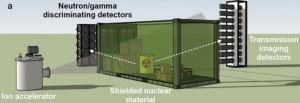Nuclear detectionImproving detection of concealed nuclear materials
Researchers have demonstrated proof of concept for a novel low-energy nuclear reaction imaging technique designed to detect the presence of “special nuclear materials” — weapons-grade uranium and plutonium — in cargo containers arriving at U.S. ports. The method relies on a combination of neutrons and high-energy photons to detect shielded radioactive materials inside the containers.

Rendering of nuclear detection schematic // Source: gatech.edu
Researchers have demonstrated proof of concept for a novel low-energy nuclear reaction imaging technique designed to detect the presence of “special nuclear materials” — weapons-grade uranium and plutonium — in cargo containers arriving at U.S. ports. The method relies on a combination of neutrons and high-energy photons to detect shielded radioactive materials inside the containers.
The technique can simultaneously measure the suspected material’s density and atomic number using mono-energetic gamma ray imaging, while confirming the presence of special nuclear materials by observing their unique delayed neutron emission signature. The mono-energetic nature of the novel radiation source could result in a lower radiation dose as compared to conventionally employed methods. As a result, the technique could increase the detection performance while avoiding harm to electronics and other cargo that may be sensitive to radiation.
If the technique can be scaled up and proven under real inspection conditions, it could significantly improve the ability to prevent the smuggling of dangerous nuclear materials and their potential diversion to terrorist groups.
The research, supported the National Science Foundation and the Department of Homeland Security, was reported 18 April in the Nature journal Scientific Reports. Georgia Tech reports that scientists from the Georgia Institute of Technology, the University of Michigan, and the Pennsylvania State University conducted this research, which is believed to be the first successful effort to identify and image uranium using this approach.
“Once heavy shielding is placed around weapons-grade uranium or plutonium, detecting them passively using radiation detectors surrounding a 40-foot cargo container is very difficult,” said Anna Erickson, an assistant professor in Georgia Tech’s George W. Woodruff School of Mechanical Engineering. “One way to deal with this challenge is to induce the emission of an intense, penetrating radiation signal in the material, which requires an external source of radiation.”
The technique begins with an ion accelerator producing deuterons, heavy isotopes of hydrogen. The deuterons impinge on a target composed of boron, which produces both neutrons and high-energy photons. The resulting particles are focused into a fan shaped beam that could be used to scan the cargo container.
The transmission of high-energy photons can be used to image materials inside the cargo container, while both the photons and neutrons excite the special nuclear material – which then emits gamma rays and neutrons that can be detected outside the container. Transmission imaging detectors located in the line of sight of the interrogating fan beam of photons
